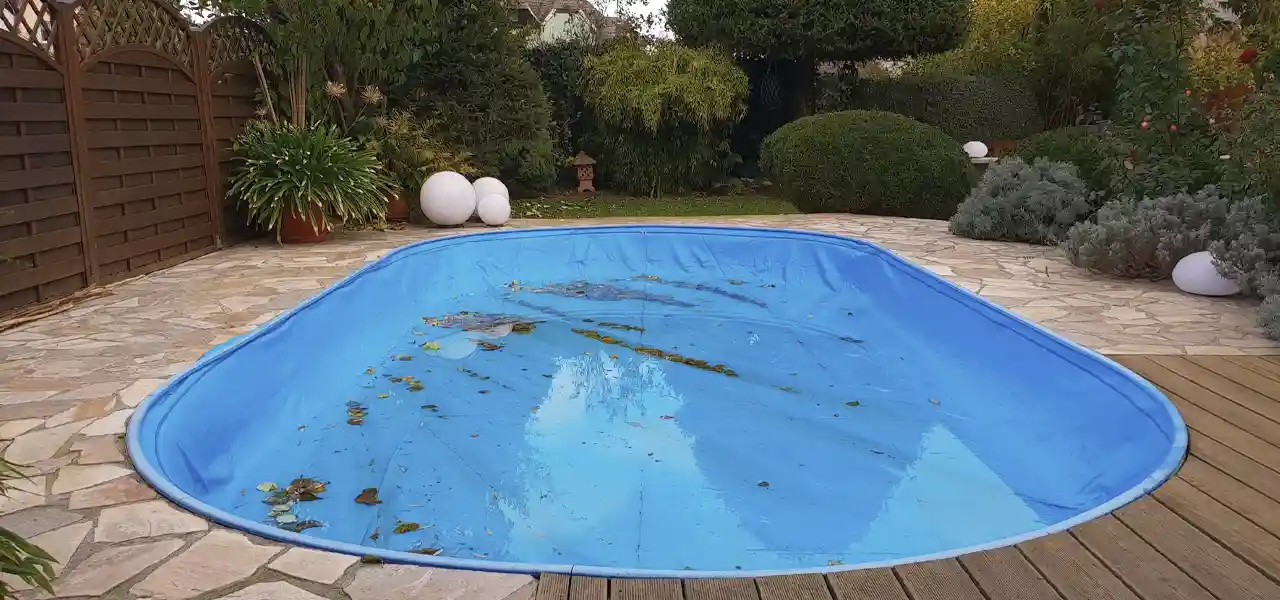FREE Standard Shipping On All Orders $100 or More!*

Common Winterized Pool Problems and How to Avoid Them
Winter can be a challenging season for pool owners. Decreased pool care might be a benefit of closing the pool, but harsh winter weather and the risk of serious pool problems can give even the most seasoned owners the winter woes. However, dealing with and preventing winterized pool problems is easier than you think! In this article, we discuss common winterized pool problems and solutions to help you maintain your pool during the off-season. The most common winter pool issues include:

Cover Failure

Freeze Damage

Hidden Leaks

Algae Growth
1. Cover Failure
Winter pool covers and safety pool covers are essential for protecting your pool during winter. They help maintain healthy water by keeping debris out of your pool. But if the cover fails, you'll have a big mess to clean up come springtime. Cover failures can happen if the cover gets damaged, either due to old age, wear and tear, or things like tree limbs landing on the cover. Rips and tears not only let debris through, but they can also let in sunlight, which facilitates algae growth. The cover can also fall into the pool if it gets weighed down with snow and rainwater, and/or if the pool's water level drops because of a leak. Here are a couple tips to prevent and resolve these common winter pool cover problems:
Reduce Cover Strain
When snowmelt or rainwater collect on top of a solid pool cover, the extra weight adds up quickly. At opening time, the extra water can make the cover difficult to remove. But the real problems happen when water levels within the pool drop, such as with an undetected pool leak. More on that in just a minute! Without proper water levels to support the cover underneath, the water weight on top causes the cover to sag. As more water accumulates, the weight can cause the cover to rip open and even collapse into the pool. And if you had murky "leaf soup" on top of the cover, all that sludge will land in the pool, requiring a major cleanup to prevent organic stains and algae growth.
The easiest way to prevent this winterized pool problem is to use a cover pump! As soon as you notice snowmelt or rainwater collecting on your cover, use a cover pump to remove the excess water. The quicker you remove the water, the better. Additionally, a leaf net is another great way to reduce strain on your cover. Leaf nets catch leaves, twigs, and other large, but lightweight debris before landing on your winter or safety cover. Rather than using a brush or skimmer net to remove the debris, you can simply peel back the leaf cover, shake off the debris, and reinstall.
PRO TIP: Before using a cover pump to remove excess water, inspect your cover for tears or holes first. If the cover is torn, the pump will not only remove water from the top of the cover, but also from the pool itself! This can cause a serious decrease in the pool's water level, and lead to further cover strain and damage.
Repair Tears and Holes
Pool covers can develop tears and holes due to falling debris, curious animals, and general wear and tear as the cover ages. Time is of the essence when dealing with cover tears to prevent excess debris from landing in the pool. A week or two before closing your pool, take your cover out and examine it closely for any damage. If you notice any minor tears, repair them with a cover patch kit. Just ensure the patch has enough time to properly seal before putting the cover over your pool.
It's always a good idea to keep a patch kit on hand, just in case your cover develops a rip or tear mid-winter. In general, damage the size of a dollar bill or less can be easily repaired. Larger rips or damage that covers a large section of the cover may require you to buy a new cover. You can also replace entire panels on a safety cover. But, because this process requires shipping the cover to a repair facility, this type of repair is not ideal once the pool is closed.
2. Freeze Damage
Freezing temperatures can wreak havoc on your pool's plumbing system. As water freezes, it expands, which can lead to significant problems if there is still water in your pipes or equipment. The increase of pressure will cause water lines to burst and equipment to break, resulting in costly repairs. Follow these tips to protect your pool and equipment from freeze damage:
Blow Out All Water Lines
To prevent freeze damage in your winterized pool, ensure all lines and skimmers are fully blown out and plugged to prevent water from getting back in. Use a skimmer guard in your skimmer to reduce the pressure caused by ice expansion. Additionally, using non-toxic pool antifreeze adds an extra layer of protection to your pool's return lines. This product prevents any leftover water in your pipes from freezing during the winter, and can come in handy if one of your return plugs starts to leak.
Drain Your Equipment
One of the easiest steps in winterizing your pool is to remove the drain plugs from your pool equipment. As long as water has a place to go and can't get trapped in a confined area, you won't have any freeze damage. Some types of equipment have multiple plugs, so make sure you remove them all. You can store the drain plugs in the pump strainer basket for safe keeping until spring.
Use Air Pillows
If you have an above ground pool, air pillows are an essential tool for a winterized pool. Air pillows sit underneath the pool cover to help break up the frozen water and minimize expansion pressure so the walls don't buckle. Just ensure the air pillows are not fully inflated when you place them under the cover. The extra space allows the pillow to absorb the water expansion.
3. Algae Growth
Even when your pool is fully winterized, it's still vital to test the water to ensure you have enough sanitizer to fight off algae growth. A murky, algae-filled, winterized pool will lead to a time-consuming and costly opening once spring rolls around! Follow these tips for keeping your pool water as healthy as possible during the winter:
- Use a high-quality phosphate remover and winter algaecide at closing time to help prevent algae.
- Take a look under your pool cover at least once a month to check for signs of algae and debris buildup.
- If temperatures are between 60°F–70°F, test the pool water every other week. And if temperatures are lower than 60°F, test the water once a month. When the pool is frozen, leave it alone.
- If your Free Chlorine level is within the normal range of 1–4 ppm, you can use a chlorine-free shock to help your existing chlorine last through the winter. If there's no chlorine left in the pool, add just enough chlorinated shock or liquid chlorine to get the levels within range. DO NOT superchlorinate a winterized pool.
- Always use a pool brush or skimmer net to circulate the water and disperse chemicals when the pool is closed. Otherwise, you may damage your pool surfaces.
- If you find debris in the pool, scoop it out, and fix the tear in the cover that let the debris in. This will help your chlorine last longer.
4. Hidden Leaks
A leaking winterized pool, no matter how minor, can quickly turn into a serious headache if not managed or fixed. Decreasing water levels put immense strain on your pool cover, and can cause it to tear or even fully collapse. And that's just one problem. The longer the leak goes undetected, the more significant the problems become. If serious enough, leaks can cause an inground pool to pop right out of the ground, due to erosion around the structure and upward pressure caused by the over-saturated ground.
As if that's not bad enough, vinyl-lined pools are at an even higher risk if they spring a leak during winter. A decreasing water level may cause any ice on the pool's surface to shift and break apart, leaving sharp, heavy ice chunks in the pool. These sharp pieces can puncture or rip the walls of the vinyl pool, turning what may have been a little leak into a major problem.
The simplest way to prevent leak damage is to look under the cover and inspect your pool's water level at least once a month. And if you suspect a leak, manage the pool's water level by refilling the pool as needed until you can repair the leak.
While winter can present several challenges for pool maintenance, these issues can be managed with regular care and attention. Staying ahead of these common problems and following the suggested solutions will help keep your pool in good condition throughout the winter months. This will save you time and money on repairs, and ensure your pool is ready for use as soon as the warmer weather arrives!